
OUR VERDICT
The new MacBook Pro is a marked improvement, but clinging onto previously divisive design decisions only continue to hurt it in straight comparisons. While this update certainly doesn’t disappoint, apply due diligence before clicking the ‘buy’ button.
FOR
- Stronger processor
- Faster RAM
- Same excellent design
AGAINST
- Subpar battery life
- Keyboard learning curve
- Awfully pricey for the parts
Replete with all the bells and whistles expected from Apple’s flagship laptop, the MacBook Pro has arrived, and it may look a little different than you remember. Nearly two years ago, Apple launched a redesign of its flagship laptop that would change Apple’s image forever.
Coming in at just over half an inch thick, the MacBook Pro wields the power of Thunderbolt 3, a single port that supports pretty much everything you can think of. Still, the MacBook Pro is not without controversy, as some of the advancements bring compromise. Instead of being able to use your old HDMI, USB and SD accessories out of the box, you’ll have to shell out more cash on adapters.
And, depending on which MacBook Pro you go with, you may find a narrow OLED display where the function keys used to be. This ‘Touch Bar,’ the main attraction of the MacBook Pro remains both a point of contention, and a major selling point. We could even see Apple extending this Touch Bar to the entire lower segment of the next MacBook Pro, as Apple is throwing around the idea of an OLED touch screen keyboard.
Luxurious, but by no means ostentatious, the MacBook Pro comes at a premium. Like most of Apple’s products, it’s built to impress when it comes to looks. It doesn’t do anything too groundbreaking, at least not in the way that Apple’s recent patents suggest of its future spill-proof and crumb-resistant MacBooks (which Apple really needs). It’s also not as affordable as Apple is positioning the rumored 13-inch MacBook with Retina display to be.
However, the MacBook Pro of today is a laptop largely successfully geared toward professionals, which is far more than can be said for the other members of Apple’s MacBook family.

Price and availability
At $1,299 (£1,249, AU$1,899), you can fetch yourself a MacBook Pro minus the Touch Bar you would otherwise find in the configuration we were sent for review. Bear in mind that, as enticing as the cheapest MacBook Pro might seem, it has only 128GB of solid-state storage inside, making it tough to recommend for users who plan on using it as their main computer.
Of course, that MacBook Pro configuration lacks another key element: the OLED Touch Bar that replaces the function keys on the low-end models. If the Touch Bar, along with Touch ID verification, is on your must-have features list, you can expect to shell out no less than $1,799 (£1,749, AU$2,699). That’s a lot more than the presumably forthcoming entry-level MacBook is going to be.
Now, while you could simply fetch more storage than the base configuration for another couple hundred bills, the unit we reviewed is a supercharged beast. That’s due in part to the fact that it sports four Thunderbolt 3 ports, double that of the non-Touch Bar models, all of which can be used to charge the device. Moreover, the processor speed has been bumped from 2.3GHz to 3.1Ghz as well.
For $100 less in the US, however, you can get a Dell XPS 13 with double the RAM and storage of the $1,799 MacBook Pro we’ve reviewed here and with a more capable Intel Core i7 CPU at that – not to mention a sharper 3,100 x 1,800 touchscreen as well as both Thunderbolt 3 and an SD card reader.
Similarly, the Surface Laptop, which can be configured with a stronger Core i7 CPU and equally capacious storage and RAM for a full 200 clams less, albeit with a slightly lower-resolution 2,256 x 1,504 touchscreen and only two legacy ports.
Bearing all this in mind, it doesn’t take a genius to see that you’re paying for the logo etched opposite your display, paired with a fantastic trackpad and a familiar operating system to boot. Nevertheless, you can save a wad of cash by trading in your old MacBook Pro to Apple itself for up to $2,500, if you’re residing in the states.
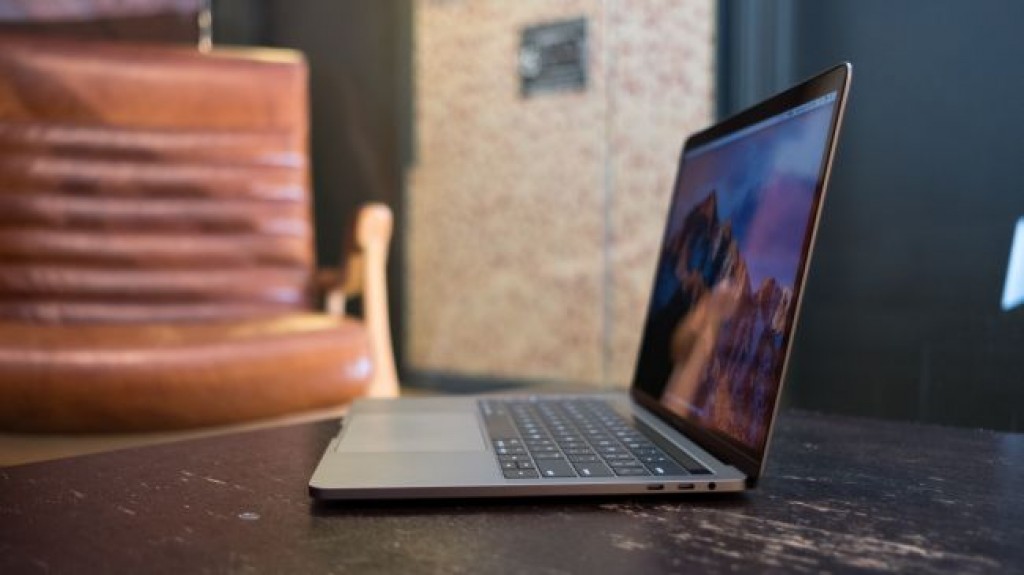
Design
Luckily, Apple’s pedigree does wonders for maintaining the MacBook Pro’s shining reputation as an absolutely beautiful and sensible computing device. That said, not much – if anything – has changed about the MacBook Pro design year over year, and that’s A-OK.
Still available in Apple’s standard space gray or silver colors (no rose gold yet), the MacBook Pro’s unibody aluminum shell is as gorgeous as ever, giving off a subdued shine through the anodization.
In terms of form factor, Apple maintains its achievement of cramming a 13-inch screen into an 11-inch frame a la the Dell XPS 13, but this laptop’s bezels are still a bit larger. Speaking of screens, Apple’s Retina display is as sharp and color-rich as ever, even more so with its new, professional-grade P3 color gamut.
However, it’s far from the sharpest out there, even among its strongest rivals, making its “Retina” claims tougher than ever to swallow. For instance, the XPS 13 can be configured with a 3,200 x 1,800 QHD touchscreen, easily outclassing the MacBook Pro in terms of pure sharpness.
This is a hugely important point for creative professionals working with media files that are high-resolution or require such a resolution to resolve minute details upon zooming in on a media file.
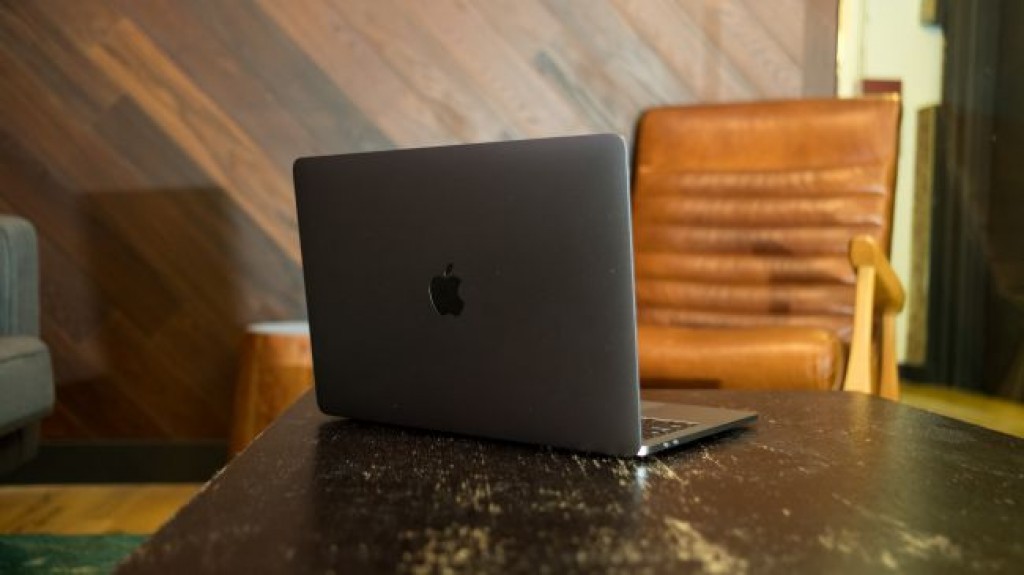
At any rate, the MacBook Pro is uniformly thinner than the XPS 13 by a hair, which starts from 0.6 inches and tapers off at 0.33 inches. The Surface Laptop, meanwhile, is marginally thinner than both at just 0.57 inches.
This is the thinnest and lightest MacBook Pro yet, and for that it feels right at home in our backpack – that is, assuming we don’t forget it’s even there. (Trust us, it has happened during this review, and it was horrifying.)
That Apple managed to craft a laptop this thin and still maintain top-firing stereo speakers, with deep and rich sound no less, should be commended when most other laptop makers just go for down-firing speakers. Instead, where speakers would normally go on an Ultrabook, Apple has placed intake fans that draw cool air in and spit it out the back just beneath the hinge.
Sure, the laptop heats up still right around that area, but said heat is far away from the more sensitive parts of your lap and far less dramatic than with previous models.
As for how Apple managed to make the MacBook Pro this thin, a key culprit is the laptop’s new keyboard with Apple’s 2nd generation butterfly mechanism, introduced in last year’s model. The improved actuation device doesn’t make the keys sit any more flush with the keyboard deck than they already were last year, but rather vastly improves the tactile feel of typing.
Feedback is much more forceful this time around, though the key travel doesn’t feel as if it’s changed much, which is the point ultimately. The keys are large enough so as not to miss given the lack of travel, though we’re not fans of the Escape key being relegated to the Touch Bar – something we’ve accidentally pressed more than once – and the tight positioning of the up and down arrow keys.
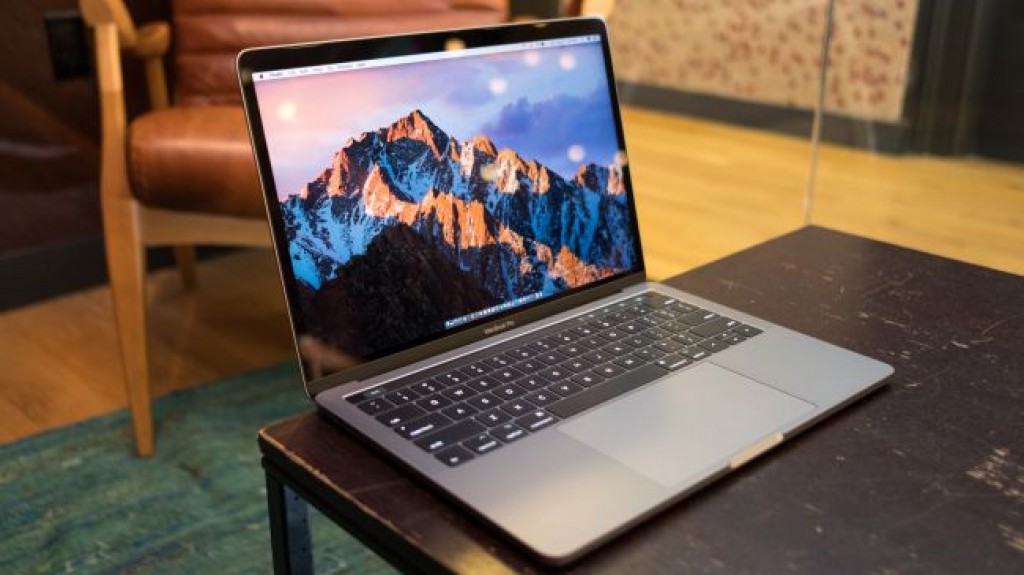
Also, we find typing on this keyboard to be louder than on Apple’s older MacBook keyboards, but perhaps that’s due to adjusting to the learning curve.
A mixed takeaway from the keyboard aside, the new-and-enlarged Force Touch trackpad was a welcome improvement last year and we’re just as happy to have it this time around. Its large size and strong palm rejection help immensely with multi-touch gestures and, more importantly, navigating the operating system the easier way, i.e. with your index finger moving the cursor and your thumb clicking the buttons.
Speaking of which, Force Touch returns to the trackpad, naturally, and it’s frankly remarkable. The vibration motors beneath the glass tracking surface vibrate so as to recreate the feeling of a mouse click, and, if Apple didn’t make such a stink about, it we’d be none the wiser. This is Apple’s “it just works” philosophy realized once again.
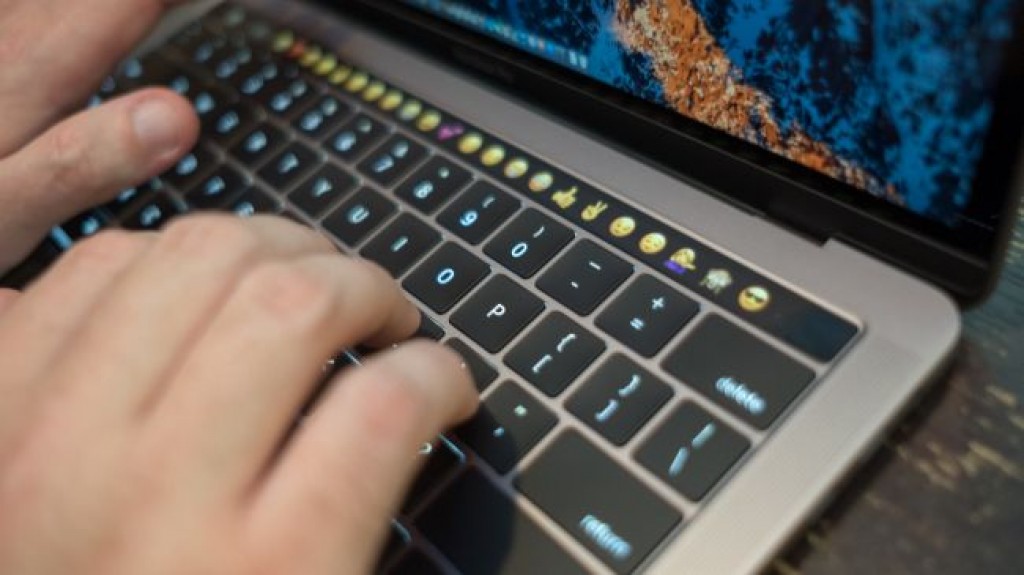
Touch Bar and Touch ID
While many have been quick to dismiss the Touch Bar since its introduction in last year’s MacBook Pro model, we’ve come down on it with a bit more understanding. You see, while we admittedly didn’t naturally come to use the Touch Bar much at all during the course of this review, its presence and potential are nevertheless noted.
While still relegated to supporting core macOS functions and a few, major third party apps (like Adobe Suite), the Touch Bar is incredibly fast at adapting to the task at hand. The strongest example of this is simply the Touch Bar’s built-in spell checker, which is constantly suggesting words no matter how fast of a typist you are.
It’s almost like having the iPhone’s autocorrect function on your MacBook.
We’ve seen tech like this attempted before, but in no way this robust and quick. The OLED touch display is incredibly responsive, and its matte coating does well to shrug off glare from strong light sources – just don’t expect much in direct sunlight. All said, we’re impressed by the technological achievement that the Touch Bar is, but still believe it requires wider third party support to become a must-have feature.
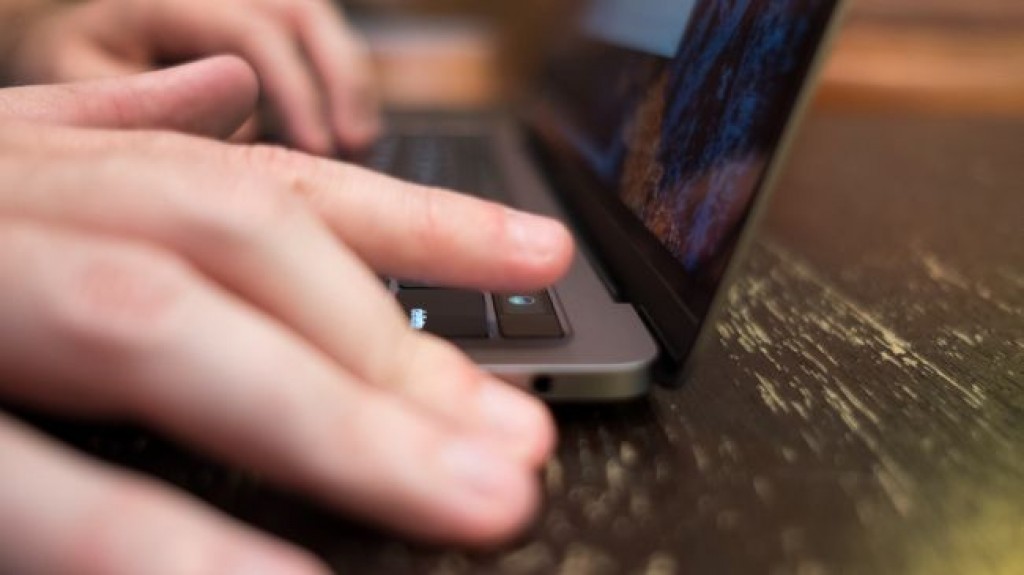
Though, having Siri as a button for easy, constant access is a major plus, given the wide control it has over macOS in comparison to other digital assistants.
The second piece of the Touch Bar offering is, of course, Touch ID. While this is the second go around for the technology, we’re nevertheless happy that biometric login is finally available on an Apple laptop. The tool works just like it does on iPhone, and it’s just as quick.
That said, we’ve found Windows 10’s iris-scanning Windows Hello tech to be faster and require nearly zero effort. (To achieve this level of immediacy with a Mac, you’d need an Apple Watch with the Auto Unlock feature activated.) Regardless, being able to securely log into the laptop, and pay for things through Safari via Apple Pay, are both features we’d be clamoring for if they weren’t there.
It shouldn’t come as any surprise that the latest MacBook Pro is rather powerful. With the latest Intel processors inside and some of fastest flash storage available in a laptop, we wouldn’t expect anything less.
During our time with the device, not once have we hit any sort of lock-up, stuttering or freezing. We’ve yet to bear witness to the so-called “beach ball of death” either.
Granted, this is during our normal workload of 10-plus Google Chrome browser tabs as well as the Slack chat app – both of which are known for their considerable demands on system resources. We also find work in Photoshop to be silky smooth, too.
It should also come as no surprise that this MacBook won’t compare well on paper to rivals we’ve reviewed, as the XPS 13 we’ve tested has a stronger processor inside. In the case of the Surface Laptop, straight performance comparisons are even harder to make, given we couldn’t run any of our standard benchmarks on it short of our battery test.
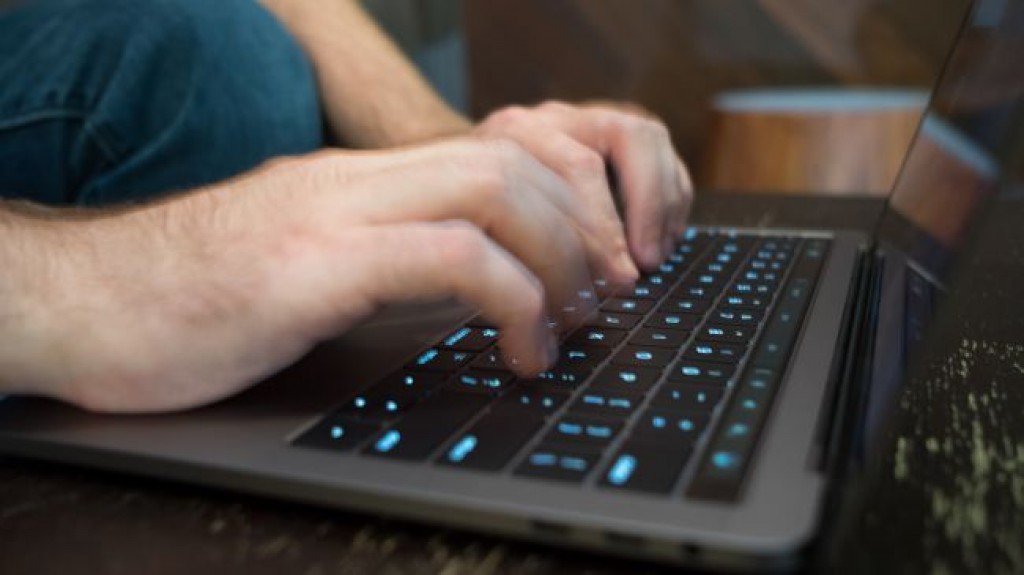
Regardless, expect a similar level of performance between the three devices, given that they all make use of the latest Intel processors and super speedy SSDs. Not to mention that this MacBook Pro houses RAM clocked at 2,133MHz to its rivals’ 1,866MHz, helping shore up some differences.
We wouldn’t worry about that Touch Bar and Touch ID module hogging any system resources either, as both are powered by an ARM-based T1 coprocessor – the very same found in Apple’s own Series 2 Apple Watch. This keeps 100% of the Intel chip’s power devoted to core computing.
Though you may be hesitant to pick up a laptop labeled ‘Pro’ without discrete graphics equipped, recent developments to the open-source Vulkan API are providing new opportunities for this MacBook Pro to flourish without the mention of Nvidia or AMD. Paired with Apple’s Metal 2 graphics framework, the MoltenVK implementation can deliver up to a 50% frame rate increase to Dota 2 running in macOS.
Still, it’s disappointing only the purchase of a 15-inch MacBook Pro will net you the more powerful, quad-core ‘HQ’ series processors. The 13-inch model we reviewed here will probably be limited to a dual-core chip for the foreseeable future.

Battery life
However, we can’t say the Touch Bar – and the coprocessor beneath it – doesn’t impact battery life. This MacBook Pro lasted for 6 hours and 37 minutes through our in-house battery test, looping 1080p video at 50% brightness and volume – with all backlighting and radios (but Wi-Fi) disabled – until it dies.
That’s nearly an hour short of how long last year’s 13-inch MacBook Pro without the Touch Bar ran on the very same test: 7 hours and 24 minutes. (Not mention well short of both the XPS 13 and Surface Laptop.) Plus, last year’s model was actually conducted at 75% screen brightness.
Between that fact and that the Kaby Lake Intel Core processor inside this year’s laptop is generally believed to be more power efficient, we’re left wondering why the two results aren’t at least closer. Both of these points are rather strong tells that the Touch Bar’s nearly always-on display and its coprocessor have a measurable impact on battery life.
This is before even mentioning that the Touch Bar seems takes up a bit of space beneath the hood that would normally be occupied by battery cells. While we haven’t gotten inside the thing, why else would the model sans Touch Bar house a 54.5-watt-hour battery whereas the model with the Touch Bar included packs a smaller, 49.2Wh power pack?
Surely, you’d want more battery to power two screens and two processors if you could manage it.
Regardless, the newest MacBook Pro is still going to last you on most US flights and perhaps even flights across the Atlantic into western Europe. That should be also good enough to get most through a work day – either way, it’s still short of Apple’s 10-hour claim.

We liked
Getting a hold of a brand new MacBook Pro never gets old. There’s a reason why countless vendors have ripped Apple’s designs over the years: because they’re that good. The Force Touch trackpad should be lauded as an engineering marvel, while the newer keyboard is surprisingly easy to use and vastly improved over the first go at the butterfly hinge. Finally, Touch ID on a MacBook Pro works nearly as fast as it does on an iPhone, and it’s a no-brainer feature at this point.
We disliked
Our most chief concern with the MacBook Pro is what it offers for the price in comparison to rivals running Windows 10. It’s almost painfully easy to configure a more powerful, longer-lasting and more pixel-dense Windows laptop at online checkout for the same price or even less. Also, despite its merit as another engineering feat, we find the Touch Bar lacking in convenience and necessity for the hit that battery life takes to accommodate the extra hardware.

Final verdict
When it comes to Apple products, especially laptops, there are some whom will never be swayed one way or the other. Either they’re vehemently for or against the MacBook, and will defend either position by any means necessary, whether that be with their money or yet another Mac vs PC Reddit thread.
However, for the scant few of you that might be on the fence (whether you’re coming from a Windows laptop or debating whether to upgrade your MacBook Pro), consider what you’re getting for the price in comparison to rivals. But, also consider the inimitable features that a MacBook Pro affords, like deeper iPhone integration than you can get anywhere else and some of the best keyboards and trackpads we’ve tested, to name a few.
The new MacBook Pro is a marked improvement over the previous generation, upping the processing power and RAM speed as well as improving the keyboard among other features. However, Apple sticking to its guns on things like Thunderbolt 3 ditching the SD card slot and display resolution only stand to hurt it in straight comparisons.
All told, the newest MacBook Pro will not disappoint both incumbent fans and those jumping the fence – just apply due diligence before clicking the ‘buy’ button.
Source: techradar.com









































